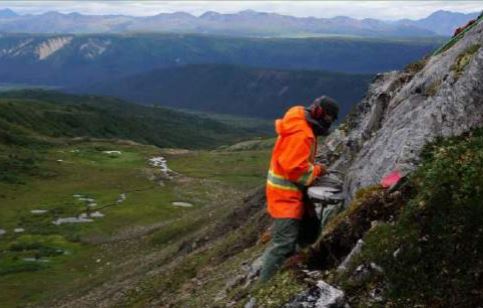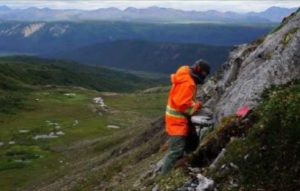Equitorial drills spodumene pegmatite at Manitoba lithium property

Channel sampling at Equitorial's Little Nahanni Pegmatite Group (LNPG) property in the Northwest Territories. Source: Equitorial Exploration Corp.
Equitorial Exploration Corp. [EXX-TSXV, EQTXF-OTCQB, EE1-FSE] on Wednesday March 21 said drill hole CT-18-02 encountered approximately 36 metres of spodumene-bearing pegmatite in core at its 100%-owned Cat Lake lithium property in southeastern Manitoba. Spodumene is the hardrock lithium mineral.

The project is adjacent to the Cat Lake mineral project (previously the Irgon Lithium Mine) owned by Quantum Minerals Corp. [QMC-TSXV, QMCQF-OTC, 3LQ-FSE].
Drill hole CT-18-02 is the second drill hole of the company’s aggressive 1,100-metre drill program. It was positioned to intersect a possible extension of the Irgon Pegmatite system, presently being explored by QMC Quantum Minerals to the west of the company’s claims.
The drill hole encountered approximately 36 metres of spodumene-bearing pegmatite (true width not determined at this time) at a depth of 126 metres downhole or 90 metres below surface.
The hole was collared approximately 200 metres southeast of the last surface exposure of the Irgon Pegmatite. Prior to being drilled, this pegmatite was buried with no surface expression, the company said.
The next few drill holes will focus on defining the orientation and extent of the newly discovered pegmatite.
“The discovery of this new pegmatite at depth may be part of the Irgon Pegmatite system or represent a totally new pegmatite system,” said Equitorial CEO Jack Bal.
“Either scenario adds significant value to Equitorial’s Cat Lake property and to the company as a whole,” he said. “We will continue to enlarge our understanding of this new discovery,” he said.
There is no ready market for lithium. Lithium prices are determined by the purity and chemistry of the material as well as the length of the contract between buyer and seller.
Brines (in salt ponds) and spodumene (hard rock) represent the two main sources of commercial lithium production.
Equitorial’s Cat Lake Project is located to the east and along strike from the former Irgon Lithium Mine property, which operated briefly as an underground mine from 1956 to 1957.
The Irgon property hosts several rare-element granitic pegmatite occurrences, one of which hosts the former Irgon Mine. During 1953-1954 the Lithium Corp. of Canada Ltd. drilled 25 holes into a formation known as the Irgon Dike and reported a historical resource estimate of 1.2 million tons grading 1.51% Li2O over a strike length of 365 metres and to a depth of 213 metres. A detailed drill program will be required to update this historical resource to current NI 43-101 standards of disclosure.
A complete mining plant was installed on the site, designed to process 500 tons of ore per day. A three-compartment shaft was also sunk to a depth of 74 metres. However, the work was suspended in 1957 due to the unfavourable market for lithium oxides at the time. At this point the mine buildings were removed.
Equitorial is aggressively developing four 100%-owned high potential lithium projects in North America. Aside from Cat Lake, the Little Nahanni Pegmatite Group is a NI 43-101 compliant hard rock lithium property in the Northwest Territories. The Tule and Gerlach Lithium Brine Projects are located in lithium-rich Utah and Nevada within easy reach of the Telsa Gigafactory #1. All four projects have demonstrated highly encouraging grades, the company said.
On Wednesday, Equitorial shares eased 10% or $0.01 to 9 cents. The 52-week range is 15 cents and 5 cents.
